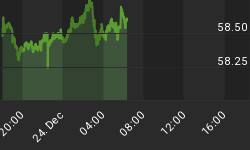Waning Bullish Conviction

- Stronger economy
- Taper odds increasing
- Bullish trends are more vulnerable
Retail Data Exceeded Expectations
The Federal Reserve has been looking for noticeable improvement in the economy to allow them to begin paring back their latest quantitative easing campaign. Thursday, economic bulls went 2-for-3. From Bloomberg:
Data today showed retail sales rose more than forecast in November as Americans bought cars and took advantage of discounts going into the holiday-shopping season. A separate report indicated applications for unemployment benefits jumped last week from an almost three-month low. The Bloomberg Consumer Comfort Index advanced for a third straight week as Americans grew more optimistic about the economy.
Better News Brings Taper Concerns

While we noted Wednesday the Fed's discussion of excess reserves tells us they continue to be concerned about economic growth, it is the market's perception of tapering that drives asset prices. From Bloomberg:
"The economic news has been generally pretty good and the Fed has supposedly has been waiting for better economic news," John Carey, a fund manager at Pioneer Investment Management who oversees about $200 billion, said in a telephone interview. "There was an expectation a few weeks ago that the Fed might wait until February or March. But now with good economic news, it's starting to seep into the market that the Fed could start tapering earlier than that."
18% Believe Taper Comes Next Week
If stronger economic data pulls taper expectations forward, a logical question is how far forward. A recent Reuters poll provides some insight:
According to a Reuters poll released on Wednesday, 32 economists expected the Fed to begin to taper in March, while 22 said it would scale back in January. Only 12 economists expected a tapering announcement next week when Fed policy-makers hold their last meeting of the year.
Waning Tolerance For Risk
When bullish economic conviction is stronger than bearish economic conviction, the stock market rises. The daily chart of the S&P 500 below shows a clear shift toward bullish conviction occurred on October 10. Notice how the blue moving average remained above the red moving average after October 10, which signaled ongoing bullish demand from investors. As of Thursday's close, the observable evidence shifted into a "it is prudent to pay attention here" mode. The blue line dropping below the red line is far from a fool-proof signal, which is why our market model uses numerous inputs. However, the observable shift in the chart is a good example of deterioration that has occurred in the market's profile.

Investment Implications - Bulls Have To Prove It
Investors who adjusted their mix between equities and bonds after the October 2007 stock market peak were glad they did. The concept of using market profiles as an asset allocation guide is described in this video clip. No one rings a bell at a major bull market peak, which means it is logical to allocate in a manner that is in line with the current market profile. Market profiles speak to the aggregate tolerance for risk. When a profile deteriorates, it tells us the market's tolerance for risk is waning. Another example of an observable shift that has recently occurred is the series of lower highs and lower lows on the chart of the NYSE Composite Index below.

In the last two sessions, our market model called for two incremental reductions in our allocation to foreign stocks (VEU). If the market can "prove it to us" by reversing some of the emerging bearish signals, we are happy to redeploy the cash from this week's sales. If deterioration continues, we will continue to reduce risk at a prudent rate based on the observable shift in the aggregate tolerance for risk. We are still long, holding numerous ETFs, including stakes in the broad U.S. market (VTI), technology (QQQ), energy (XLE), and small caps (IJR).















